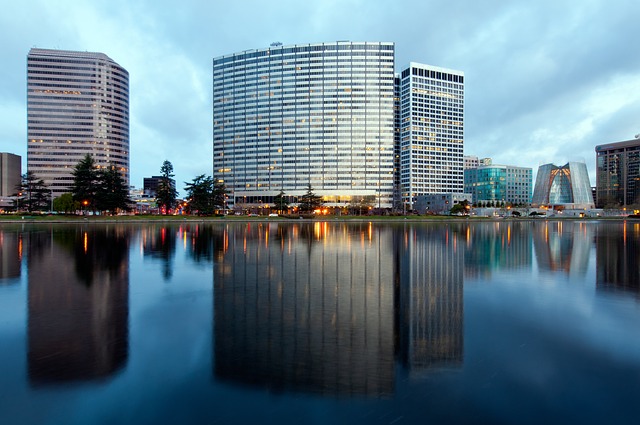This article is an excerpt from the book called “East Bay Then & Now” by “Dennis Evanosky And Eric J. Kos”. This blog post takes our readers to the historic Oakland City memories. Ridge Tree service in Oakland works around these landmarks in the city and we are proud to be part of Oakland. Thanks to the author for the useful content.
Broadway, Oakland
An automobile makes its way up Broadway as a horse and wagon approaches from Telegraph Avenue in this early twentieth-century photograph of the intersection of these streets. Nineteenth-century wooden structures abound, suggesting that this photo was taken before the 1906 earthquake. The structures include a three story flatiron building. The Latham family would replace the oversized flagpole with a fountain; more urban look. In just a few years skyscrapers would appear on the scene.
Oakland Skyline
Oakland’s Beaux-Arts city hall dominates the skyline in this 1915 photo taken from Alameda’s United Engineering Works. A cluster of nearby skyscrapers joins the cityscape. The Alameda County Courthouse dome peeks out at the far left and the Hotel Oakland’s twin Queen Anne-style towers can be seen on the right. Smoke from the boilers at the Piedmont Baths rises up from behind the hotel. The Webster Street Bridge crosses the Oakland estuary next to the United Engineering Works, and a steam schooner lies moored at the Hogan Lumber Company on the Oakland side next to the bridge.

A much different, more vibrant Oakland presents itself today. City Hall stands tucked behind a modern high rise in this photo taken from the silo in Alameda near the Posey Tube. Jack London Square lies along the Estuary on the Oakland side. The Webster Street Bridge is gone, as is the Harrison Street Bridge; the Posey and Webster tube replaced them. Bridges were considered impediments to shipping traffic along the busy estuary. The Federal Building (left) and the Tribune tower 9right) stand out along the busy estuary. The Federal Building (left) and the Tribune Tower (right) stand out along the skyline. Close investigation will show the Hotel Oakland’s twin towers are still there; it is now a home for senior citizens.
Tenth and Washington, Oakland
The Oakland Convention Center now stands at the site of the old pond. This state of the art center welcomes visitors and conventions from all over the world. The center also has a visitor’s bureau that assists anyone with questions about visiting, living in, or even writing about Oakland. The Golden State Warriors, Oakland’s professional basketball team, use the center for practices.
Lake Merritt Boathouse, Oakland
Boaters and spectators enjoy a day at the Lake Merritt Boathouse. Lake Merritt is a 160-acre saltwater lagoon formed from a slough that was once part of the San Antonio Creek. The lake became a fashionable place to live as nineteenth-century developers-such as Samuel Merritt, for whom the lake is named-built lakeside homes for the wealthy. Only one of these homes remains today: the Camron Stanford House, next to the boathouse. In 1870, Lake Merritt became an official wildlife refuge, providing sanctuary for migratory birds. Thousands of waterfowl winter here, attracted by the food and shelter available on the lake.
Fourteenth and Webster, Oakland
J.W.Trucker and his son located their paint store at Fourteenth and Webster streets, just across from the narrow gauge train station that stood at the present-day site of the Downtown Merchants Parking Garage. They pose here with their nineteenth-century status symbol: a horse and buggy. A train and its crew-in the right place at the right time-pose for the camera as well. Sign painter William J. Oakes shared the building with the Tuckers. Notice the paint barrels used as decoration on the building.
Maclise Drugstore Building, Oakland
The Maclise Drugstore Building anchors the triangle, or gore, formed by San Pablo Avenue and clay Street at Seventh Street. The three-story, neoclassical brick and stone commercial building dwarfs the adjacent buildings on San Pablo Avenue and the one on Jefferson Street. It is dwarfed in turn by Oakland’s Beaux Arts-style city hall. Built between 1898 and 1899, the building may have been the keystone to plans for developing this corner. Seven years later, the First National Bank Building just down San Pablo rose to grace another downtown gore; in 1914 the Cathedral Building decorated a third.
Continue reading about “Berkeley City”

